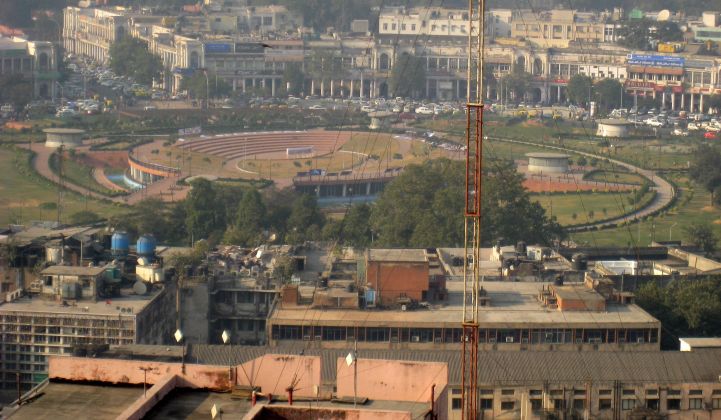India is planning some large energy investments over the next five years, including $100 billion for renewable energy, $50 billion in transmission and distribution grids, and $10 billion for a nationwide smart grid overhaul.
Now it’s adding a new technology to the mix, meant to tame problems caused by peak electricity demand.
This week, technology provider Honeywell and Tata Power Delhi Distribution Limited, the utility serving about 5 million residents in the city of Delhi, unveiled the country’s first large-scale implementation of an automated demand response (ADR) program. Over the past year, the partners have hooked up more than 160 commercial and industrial customers with internet- and cellular-connected load controls capable of shedding about 11.5 megawatts of load at a moment’s notice.
That’s about 1 percent of the utility's typical peak load of 1,150 megawatts. But it’s a critical sliver of demand to target, Vishal Agarwal, energy and utilities leader for Honeywell India, said in an interview this week. Under the country’s broader smart grid roadmap, “it’s becoming more and more mandatory that India look at programs like ADR and demand-side management to help the whole country optimize its energy usage,” he said.
India’s utilities are paying very high prices for peak power and struggling to keep up with growing electricity demand that threatens to overwhelm the country’s power generation capacity. They’re also striving to reduce their large share of electricity lost to inefficiency and theft, as well as to bolster reliability of a system that experiences common power outages, not to mention major crises like the 2012 blackout that left nearly half the country’s 1.2 billion people without power.
Demand response can help manage the peak demand that can lead to blackouts, as well as reduce the need for costly peak-power purchases, Agarwal noted. Meanwhile, connecting individual buildings via the internet connections and Landis+Gyr smart meter network that Tata Power has deployed in Delhi will help bring back the data the utility needs to continue improving its efficiency, he said.
Honeywell’s deployment in India is using OpenADR 2.0b, the latest version of the open standard developed in the United States to allow utilities and demand response aggregators to communicate with networked building control systems and devices. That’s the same technology that Honeywell has put to use in about 20 projects in the U.S., Europe and China.
Automated demand response is still a relative rarity in the United States, compared to proprietary systems like those run by demand response aggregator EnerNOC, or the legacy methods that use phone calls or emails to inform building facility managers to turn down big loads or fire up backup generators.
“India uses manual demand response as well,” Agarwal said, though at a much smaller scale than in the United States. “But that is very selective, and it’s going to go out of fashion,” as India’s smart grid mandates require stronger IT and communication links between utilities and their customers, he said.
That’s the trend in other countries as well. The spread of ubiquitous internet access and wireless networks, along with the increasing level of intelligence being built into industrial controls, HVAC systems, lighting networks and other big building loads, is making automated demand response a cheaper and more user-friendly alternative to old-fashioned manual methods.
Honeywell is one of the leaders in automated demand response, but it’s not the only one. Companies including Siemens, Alstom, Schneider Electric, EnerNOC, Comverge, Cisco, Hitachi, Toshiba, Fujitsu, Enbala, Powerit, and many others are using OpenADR to connect buildings to the grid and vice versa.
Europe is an emerging market for fast-acting automated demand response, as are Australia, Japan and Korea. China is a potentially huge market, although its energy regulatory structure presents some roadblocks for companies trying to build a U.S.-style demand-response business.
India could be the next big opportunity. Last year, the OpenADR Alliance, a group of about 100 companies using the standard, announced a partnership with the India Smart Grid Forum, a coalition of private companies and India’s Ministry of Power that was created to boost the adoption of smart grid technology.
India’s moves into automated demand response aren’t limited to Delhi. In Mumbai, utility Reliance Infrastructure has partnered with U.S. startup Innovari on an ADR pilot project, though Agarwal noted that the Mumbai project is smaller than Honeywell’s. Both projects are partially funded by grants from the U.S. Trade and Development Agency, which has played a big role in bringing non-Indian companies like General Electric and IBM into the country’s early smart grid projects.
At the same time, Indian IT giants like Infosys, Wipro and Tata are going to play a huge role in this transformation of the electric sector, starting with 14 regional smart grid projects launched in 2013. Tata Power, the subsidiary of giant conglomerate Tata Group, has 8,621 megawatts of generation including coal, hydro, solar and wind, as well as big retail energy operations in major cities, and IT subsidiary Tata Consultancy Services is working with 13 of the 18 Indian states on revamping their utility IT infrastructure.
Tata Power’s plans for automated demand response are set to expand soon, Agarwal noted. “They wanted to have a successful rollout for the first phase,” he said -- something that Honeywell and Tata Power have shown they can provide over the course of about 10 test runs of their platform. In the next phase, “they want to implement this across thousands of buildings,” with a target of reducing peak demand by 5 percent to 10 percent.
Honeywell’s press release noted that the same technology applied across all buildings in India could reduce the country’s peak energy requirements by about 7 percent, or an estimated 10.5 gigawatts. That’s a highly unrealistic target, to be sure, but still an interesting statement of the potential of demand response to fit into the country’s wider-ranging energy goals.
A 2013 study from Lawrence Berkeley National Laboratory (PDF) takes a deep look at India's challenges and opportunities on the demand response front.



